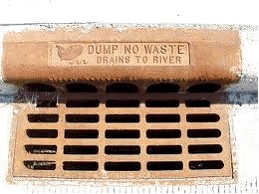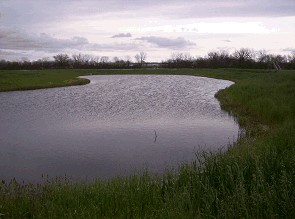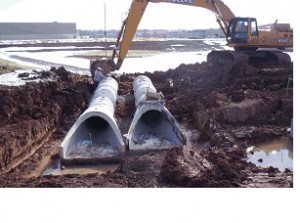Historically the storm sewer system’s primary function was to remove the rainwater from the streets. The water enters catchbasins, like the one shown below, which are connected to underground pipes. The pipes then transport the water to Lake Winnebago, the Fox River or the Neenah Slough (the water does not go to the treatment plant).
Today the storm sewer system is also used to protect the environment. The City and businesses have been installing structural devices such as detention ponds, bio-filters and cleaning manholes to remove sediment and nutrients from the runoff before it enters the lake. The City also sweeps streets, picks up leaves and cleans catch basins to keep the water entering our waterways clean.
Permits and Requirements
The City of Neenah is
required to have a Municipal Separate Storm Sewer System (MS4) permit
along with other larger communities in the state as per Wisconsin Adm.
Code NR 216. As part of the permit the City must perform the activities
list below:
- Public Education & Outreach – The City is a member of NEWSC
(Northeast Wisconsin Stormwater Consortium) which makes public
appearances and provides information to the public on stormwater issues
and coordinates activities like the Fox River Watershed Cleanup held in
spring. Look for their banner at the next public function your at and
stop by to learn more about what you can do to help improve the water
quality of our lakes and rivers.
- Public Involvement & Participation – The City sponsors events
like Renew the Slough and rain-barrel building workshops. Watch for
events dates in the City’s quarterly newsletter.
- Illicit Discharge Detection & Elimination – We want to make
sure pollutants don’t end up in our waterways. The City inspects
outfalls to the Neenah Slough and Lake Winnebago annually to look for
any signs of pollution. If you notice anything that looks suspicious
such as discolored water, suds, oil sheen, etc., please call the Public
Works office so we can inspect the discharge.
- Construction Site Pollution Control – Construction activities that
disturb the soil can lead to erosion and deposition of soil in our
surface waters. Construction activities that disturb the soil require
an erosion control permit per City ordinance. As part of the permit,
the City will review with the owner what types of erosion control
devices are appropriate and conduct inspections to ensure they are
working properly.
- Post Construction Management – New subdivisions and developments are
required to install structures such as detention ponds, bio-filters and
rain gardens to clean the rain water before it leaves the site and
reduce the peak flows after an intense rainfall.
- Pollution Prevention – The City implements a number of BMPs (Best
Management Practices) to prevent pollutants from the City Garage and
streets from entering the storm sewers. Street sweeping, catch basin
cleaning and leaf pick up are some of the activities performed.
- Stormwater Quality – The City is required to reduce the amount of total suspended solids (TSS) entering our waterways by 20%.
The City also has to comply with the standards set by the Lower Fox
TMDL (Total Maximum Daily Load) and the Upper Fox/Wolf TMDL. The TMDLs
establish the maximum amount of total suspended solids (TSS) and total
phosphorous (TP) that the City’s storm system may release to the
waterways. The City has a number of years to meet the TMDL requirements
which will require numerous ponds and other best management practices
BMPs. More information on these TMDLs can be found on the DNR website http://dnr.wi.gov/topic/tmdls/.
2020 MS4 Report
Stormwater Utility
A stormwater utility
was created to fund the structural and operational best management
practices (BMPs) required to comply with the City’s MS4 permit and TMDL
limits.
The utility charge is based on an equivalent runoff unit (ERU). An
average single family home is equivalent to 3,138 square feet of
impervious area or one ERU. More information on the stormwater utility
and charges may be found in the Neenah Code of Ordinances Sec. 17-101 to
140 (click here).
Post-Construction Stormwater Management
 Construction
Construction
sites with 20,000 square feet or more of impervious surface disturbance
and sites with one acre or more land disturbance shall reduce the total
suspended solids (TSS) and shall reduce the peak discharge prior to the
runoff leaving the site.
- New development sites shall reduce the TSS by 80%.
- Redevelopment sites shall reduce the TSS by 40%.
- Parking lot resurfacing shall be considered routine maintenance
until the lower half of the granular base is disturbed. If the lower
half of the granular base is disturbed it will then be considered
redevelopment.
- The peak post-development discharge rate shall not exceed the peak
pre-development discharge rate for the 2 year, 10 year, and 100 year,
24-hour design storms.
- TR-55 methodology shall be used for peak discharge calculations
- Peak pre-development discharge rates shall be determined using a
“meadow” condition with the following runoff curve numbers for the
corresponding soil group: A-30, B-58, C-71, D-78
All requirements for Post-Construction Stormwater Management can be
found in Sec. 22-322 to 350 of the Neenah Code of Ordinances (click here).
Learn how you can make a difference at RENEW OUR WATERS.
Become involved with stormwater projects that improve our community at Sustainable Neenah.
Construction Site Erosion Control
 Erosion
Erosion
control during construction is perhaps the single most important
element in protecting our waterways from sediment no matter how small
the project. Whenever the ground is disturbed there is a potential for
soil to be washed away and carried into our lakes and streams.
All land disturbing construction activity within the City of Neenah
shall obtain a permit prior to commencing. Permit requirements can be
found in Sec. 22-290 of the Neenah Code of Ordinances (click here).



